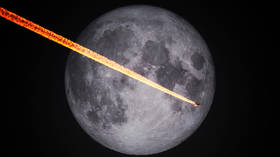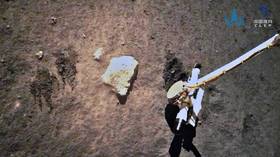Lunar crater from mystery rocket impact found

A rocket of unknown origin crashed into the Moon, leaving an unusual crater, NASA’s Lunar Reconnaissance Orbiter recently revealed. Astronomers noted the rocket body heading toward the Moon late last year, and it finally hit Earth’s satellite on March 4, creating an unusual double-crater formation.
The double crater suggests the rocket body “had large masses at each end,” according to a press release NASA published on Friday. It consists of an eastern crater about 18 meters in diameter (19.5 yards) on top of a western crater of about 16 meters in diameter (17.5 yards).
The crater is so unusual precisely because no previous rocket body impact on the Moon has created a double crater. Four Apollo SIV-B craters were larger than the recent impact in maximum width, ranging from 35 to 40 meters (about 38 yards), though the maximum width of the new crater – 29 meters (about 31.7 yards) was similar to that of the Apollo rockets.
NASA did not mention whose rocket its orbiter had spotted in the press release, though American astronomer Bill Gray suggested in February that it was a booster stage from China’s Chang’e 5-T1 lunar mission, launched in October 2014. Gray initially misidentified the rocket as a stage from a SpaceX Falcon 9.
The Chang’e-5 probe, which landed on the Moon in December 2020, gathered a number of rocks for testing back on Earth, revealing water molecules were present at rates of up to 180 parts per million in some areas of the satellite.
Several nations have been landing or planning Moon missions in recent months. Russia has scheduled its Luna-25 Moon lander mission for September, according to an announcement last month by Roscosmos head Dmitry Rogozin, while the US is aiming to launch its Artemis manned Moon mission by 2024.
Meanwhile, the Pentagon has warned that increasing collaboration between Russia and China in space poses a risk to its own supposed dominance of the domain. The US is competing with the two nations to build the first Moon base, with dreams of exploiting the potential mineral resources of Earth’s only satellite and potentially even building nuclear reactors on it.













